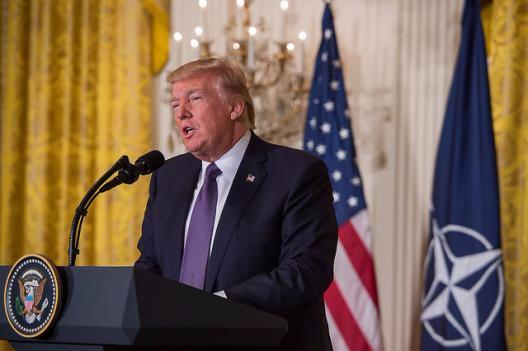 In Donald Trump’s eyes, NATO Secretary-General Jens Stoltenberg was actually the head of an alliance that history had made superfluous. The new American president made clear during his election campaign that he considered NATO to be a Cold War relic – cumbersome, expensive and useless. But when Stoltenberg appeared at a joint press conference during a visit to the new U.S. leader in the White House, nary a word indicated any resentment over NATO. “I said it was obsolete. It is no longer obsolete,” Trump said in a spectacular turnaround.
In Donald Trump’s eyes, NATO Secretary-General Jens Stoltenberg was actually the head of an alliance that history had made superfluous. The new American president made clear during his election campaign that he considered NATO to be a Cold War relic – cumbersome, expensive and useless. But when Stoltenberg appeared at a joint press conference during a visit to the new U.S. leader in the White House, nary a word indicated any resentment over NATO. “I said it was obsolete. It is no longer obsolete,” Trump said in a spectacular turnaround.
So what happened?
Stoltenberg chuckles at the question before fastening his seat belt. The Belgian air force passenger jet taxis onto the runway at the airport in Rome as it prepares to take off for Brussels. “We learn something new every day,” he says. “Donald Trump and I discussed how NATO must further develop because the world has changed….
“We are not increasing our defense spending in order to do President Trump a favor,” Stoltenberg says, leaning back in his leather seat. “We are doing exactly what we promised at the summit in Wales.”
In response to Putin’s annexation of Crimea, NATO member-state leaders agreed at a September 2014 summit, long before Trump’s election, to increase their countries’ defense spending to 2 percent of gross domestic product (GDP) over the next 10 years . Since then, defense budgets have risen slowly in many NATO countries, but many of Stoltenberg’s meetings bear little fruit, such as the one with Paolo Gentiloni in Rome, from which he is now returning. Italy’s prime minister said many nice things about the alliance, but he was careful to avoid making any concrete pledges. For his part, Stoltenberg praised Italy as a “vital ally” – despite the fact that the country is still far from reaching the 2-percent target….
In contrast to Stoltenberg, the Americans have been considerably more assertive in an effort to ensure their president’s upcoming Brussels visit is a success. Trump is under pressure domestically and a policy victory from Brussels could help. Especially “on the issue of NATO in the south,” the alliance is “confronted with strong challenges for greater visibility,” one NATO diplomat wrote in a cable back to his home country. In other words, Trump isn’t just seeking money: He also wants to see increased engagement. At the recent summit of NATO ambassadors, the Americans made the issue official: They want NATO to formally join the U.S.-led coalition against Islamic State.
Some Europeans remain hesitant. The Germans and the French have argued that all NATO members are already involved in deployments against Islamic State. Germany, for example, has deployed Tornado aircraft to conduct air reconnaissance in Syria. Official NATO membership in the coalition, they argue, would change little and could even be harmful, handing the terrorists a pretext to brand the intervention as a Western crusade.
On the other hand, the demand from Washington opens the door to a possible deal. NATO could formally join the anti-IS operation, but member states would not be required to do more than they already are. In return, the U.S. would show lenience on the 2-percent target….
Stoltenberg is familiar with the sensitivities and he is trying to build bridges. “No one expects the participation of NATO soldiers in the Syrian civil war and it’s also not up for debate,” he says. But NATO troops have been training anti-IS fighters in Iraq since January and he could imagine increasing their number. “The training of local forces, like in Iraq and Afghanistan, is in my view one of the best weapons for fighting terror,” he says. In addition, the alliance is also considering using its AWACs flights not just for reconnaissance, but also to better direct coalition aircraft over Syrian air space. “It’s conceivable that we will rely more heavily on the AWACs aircraft above Turkey,” Stoltenberg says.
A bit more of the same, in other words – and it seems doubtful whether it would be enough for Trump. And the Americans have even taken it upon themselves to provide visible evidence of how seriously NATO takes the war on terror. As a sort of reminder to the Europeans, the president plans to unveil a sculpture in front of the new NATO headquarters himself. It’s made of metal ruins from the World Trade Center – a remnant of the Sept. 11, 2001, terrorist attacks.
Image: President Donald Trump, April 12, 2017 (photo: NATO)
